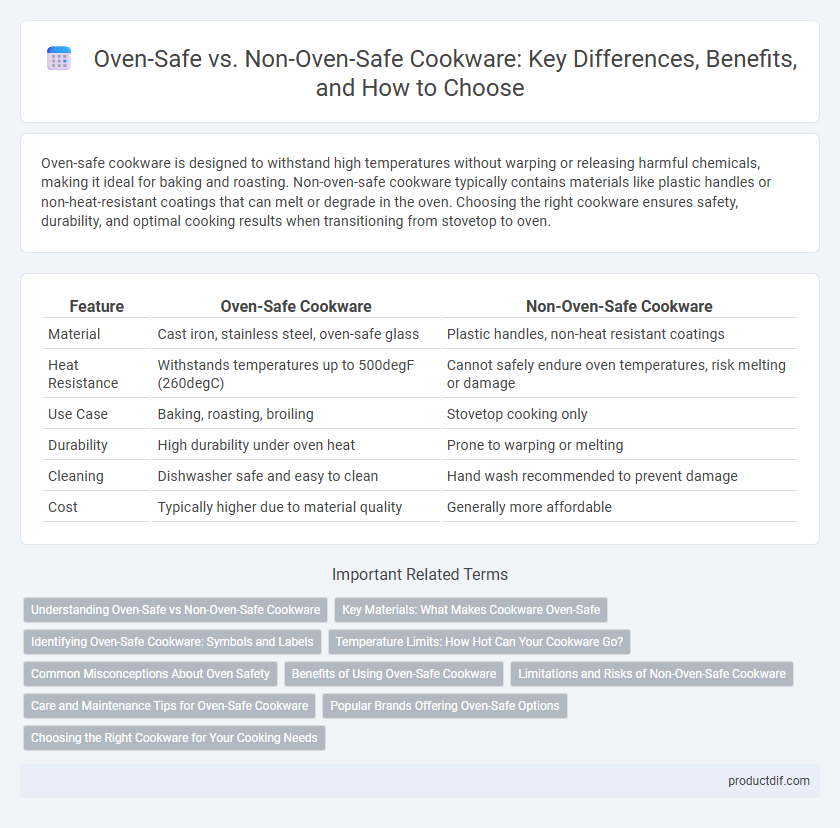Oven-safe cookware is designed to withstand high temperatures without warping or releasing harmful chemicals, making it ideal for baking and roasting. Non-oven-safe cookware typically contains materials like plastic handles or non-heat-resistant coatings that can melt or degrade in the oven. Choosing the right cookware ensures safety, durability, and optimal cooking results when transitioning from stovetop to oven.
Table of Comparison
| Feature | Oven-Safe Cookware | Non-Oven-Safe Cookware |
|---|---|---|
| Material | Cast iron, stainless steel, oven-safe glass | Plastic handles, non-heat resistant coatings |
| Heat Resistance | Withstands temperatures up to 500degF (260degC) | Cannot safely endure oven temperatures, risk melting or damage |
| Use Case | Baking, roasting, broiling | Stovetop cooking only |
| Durability | High durability under oven heat | Prone to warping or melting |
| Cleaning | Dishwasher safe and easy to clean | Hand wash recommended to prevent damage |
| Cost | Typically higher due to material quality | Generally more affordable |
Understanding Oven-Safe vs Non-Oven-Safe Cookware
Oven-safe cookware is designed to withstand high temperatures without warping, melting, or releasing harmful chemicals, typically made from materials like stainless steel, cast iron, or oven-safe glass. Non-oven-safe cookware often contains components such as plastic handles or non-heat-resistant coatings that can degrade or become hazardous when exposed to oven heat. Recognizing the difference ensures safe cooking practices and preserves the integrity and longevity of your cookware.
Key Materials: What Makes Cookware Oven-Safe
Cookware made from materials such as cast iron, stainless steel, and oven-safe ceramics can withstand high temperatures without warping or releasing harmful chemicals, making them ideal for oven use. Non-oven-safe materials like certain plastics, silicone not rated for high heat, and cookware with plastic handles tend to melt or degrade under oven conditions. Understanding the thermal properties and construction of key materials ensures safe and efficient oven cooking, extending cookware lifespan and maintaining food quality.
Identifying Oven-Safe Cookware: Symbols and Labels
Oven-safe cookware is commonly marked with specific symbols such as an oven icon or temperature limits stamped on the bottom or packaging, indicating it can withstand high temperatures without damage. Labels often include precise maximum oven temperatures, typically ranging from 350degF to 500degF, helping consumers select appropriate cookware for baking or roasting. Materials like cast iron, stainless steel, and tempered glass are frequently designated as oven-safe through these visible indicators on product labels.
Temperature Limits: How Hot Can Your Cookware Go?
Oven-safe cookware typically withstands temperatures ranging from 350degF to 500degF, depending on materials like stainless steel, cast iron, or silicone. Non-oven-safe cookware, often made from plastic or certain coated metals, can deform or release toxins when exposed to heat above 200degF. Knowing the temperature limits of your cookware is essential to prevent damage and ensure safe cooking practices.
Common Misconceptions About Oven Safety
Many people mistakenly assume all cookware labeled as heat-resistant is oven-safe, but materials like plastic handles or non-metal accents often cannot withstand oven temperatures. Glass and ceramic are generally oven-safe, provided they are free from cracks and manufactured for high-heat use, unlike some non-stick pans that degrade or release toxins when overheated. Always verify manufacturer guidelines, as oven-safe ratings depend on maximum temperature thresholds and specific design features, preventing damage or safety hazards.
Benefits of Using Oven-Safe Cookware
Oven-safe cookware withstands high temperatures without warping or releasing harmful chemicals, ensuring durability and safety during cooking. Using oven-safe pots and pans allows seamless transitions from stovetop to oven, enhancing cooking versatility and efficiency. These materials retain heat evenly, improving food quality by promoting consistent cooking and browning.
Limitations and Risks of Non-Oven-Safe Cookware
Non-oven-safe cookware often contains materials like plastic handles or non-heat-resistant coatings that can melt, warp, or emit toxic fumes when exposed to oven temperatures. Using such cookware in the oven risks damaging the pan and compromising food safety due to potential chemical leaching or structural breakdown. This limitation restricts cooking methods, preventing transitions from stovetop to oven, and reduces the versatility of non-oven-safe pots and pans.
Care and Maintenance Tips for Oven-Safe Cookware
Oven-safe cookware requires specific care and maintenance to prolong its durability and performance, such as avoiding rapid temperature changes that can cause warping or cracking. Use non-abrasive cleaners and avoid metal utensils to prevent scratching the surface, especially on non-stick or enameled pieces. Regularly inspect seals and handles to ensure they remain secure and heat-resistant for safe oven use.
Popular Brands Offering Oven-Safe Options
Popular cookware brands such as Le Creuset, Lodge, and Cuisinart offer extensive lines of oven-safe options designed to withstand high temperatures without warping or releasing harmful chemicals. Le Creuset's enameled cast iron Dutch ovens and Lodge's seasoned cast iron skillets provide durability and heat retention ideal for baking and roasting. Cuisinart's stainless steel and hard-anodized aluminum collections also feature oven-safe pieces compatible with temperatures up to 500degF, catering to versatile cooking needs.
Choosing the Right Cookware for Your Cooking Needs
Oven-safe cookware is designed to withstand high temperatures, making it ideal for recipes that require both stovetop and oven cooking, such as casseroles and braises. Non-oven-safe cookware, often made with plastic handles or non-heat-resistant coatings, limits cooking methods to stovetop use, which may restrict versatile meal preparation. Selecting cookware based on oven-safe properties ensures durability, versatility, and optimal performance aligned with your cooking techniques and temperature requirements.
Oven-Safe vs Non-Oven-Safe Infographic

 productdif.com
productdif.com